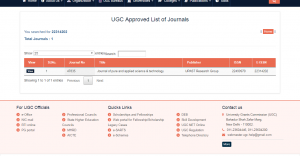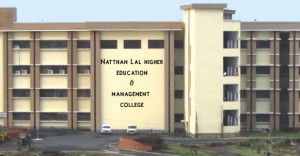Studies on Physicochemical Parameters to Assess the Ground Water Quality in Ballia District – Dr. Mala Kumari.
Studies on Physicochemical Parameters to Assess the Ground Water Quality in Ballia District
Dr. Mala Kumari
Department of Chemistry, S.C. College, Ballia, U.P., India.
No water, no life, no blue, no greenie without water life is impossible. The quality of water change day by day depending upon sources [1] People on globe are under tremendous threat due to undesired changes in the physical, chemical and biological characteristics of air, water and soil. Due to increased human population, industrialization, use of fertilizers and man-made activity water is highly polluted with different harmful contaminants. Natural water contaminates due to weathering of rocks and leaching of soils, mining processing etc. [2]. It is necessary that the quality of drinking water should be checked at regular time interval, because due to use of contaminated drinking water, human population also suffers from varied of water borne diseases. These could have serious heal. The availability of good quality water is an indispensable feature for preventing diseases and improving quality of life. It is necessary to know details about different physico-chemical parameters such as Colour, Odour, Temperature, Hardness, pH value, Electrical Conductivity (EC), Total Dissolved Solid (TDS), Total Dissolved Oxygen (DO), Total Hardness (TH), Calcium (Ca2+), Magnesium (Mg2+), Chloride(Cl–), Sulphate (SO42-), Chemical Oxygen Demand (COD), were analyzed for testing of water quality .and compared with maximum permissible limits. The drinking water recommended by aome water analysis reports with physic-chemical parameters have been given for the exploring parameter study. Guidelines of different physic-chemical parameters also have been given for comparing the value of real water sample.
Keyword: Water, Physio – chemical, Parameters, Hardness, EC, OD, COD, TDS, DO.
 Full Paper
Full Paper
Development and characterization of TiO2 based Pd-GATE MOSFET Hydrogen sensor – Pradeep Kumar Yadav, Ruby Yadav and Sanjay Kumar Singh.
Development and characterization of TiO2 based Pd-GATE MOSFET Hydrogen sensor
Pradeep Kumar Yadav1,*, Ruby Yadav2 and Sanjay Kumar Singh3
1,2Physics Department, Meerut College, Meerut, U.P., India.
3Directorate of Higher Education, U.P., Pryagraj, U.P., India.
*email: yadav62pk@gmail.com
The development and characterization of Pd-gate MOSFET hydrogen sensor having TiO2 as gate oxide, has been presented. The response of the fabricated sensor on exposure to hydrogen gas at room temperature has been studied. Also, the temperature dependent response of the device has been studied.
Key words: Pd-Gate, sensor, TiO2.
 Full Paper
Full Paper
Synthesis and Characterization of Copolymer Nanocomposite N-Methyl Pyrrole (NMPy) and Aniline-2-Sulphonic Acid (ASA) – R. Rathore and Ajay Chauhan.
Synthesis and Characterization of Copolymer Nanocomposite N-Methyl Pyrrole (NMPy) and Aniline-2-Sulphonic Acid (ASA)
R. Rathore1,* and Ajay Chauhan2
1,*Department of Chemistry, Meerut College, Meerut, U.P., India.
2Department of Physics, Meerut College, Meerut, U.P., India.
1,*email: r.rathore_@hotmail.com
Copolymer nanocomposite of N-Methyl pyrrole (NMPy) and Aniline-2-Sulphonic acid (ASA) doped with HCl was synthesized using chemical oxidative polymerization. Ammonium persulfate (APS) was used as an oxidant. The nanocomposite samples were characterized for structural configurations by FTIR, TGA and XRD. Four probe method was adopted for the measurement of electrical conductivity. FTIR confirms the formation of copolymer and its structure. XRD analysis shows the amorphous nature of polymer nanocomposite. The electrical conductivity of sample was measured by using four probe method. Size and surface morphology was demonstrated by SEM.
Key words: Nanocomposite, copolymer, XRD, TGA, SEM, four probe method.
 Full Paper
Full Paper
Natural Pesticides and Synthesized Pesticides: Comparison and Their Impact on Soil Properties – Smita Chaturvedi and Vinod Kumar.
Natural Pesticides and Synthesized Pesticides: Comparison and Their Impact on Soil Properties
Smita Chaturvedi and Vinod Kumar
Department of Chemistry, Agra College, Agra, U.P., India.
Email: smitachat15@gmail.com; vinodkchem@gmail.com
Our country mostly depends on our agricultural land, yield and farming. The conservation and quality management of soil is our need, without which any nation cannot survive. It is assumed that the natural pesticides are environmentally friendly and synthetic must have some harmful effect on soil. Di-thiocarbamates were discovered as a class of chemical compounds early in the history of Organo-sulpher chemistry. The strong metal binding properties of dithiocarbonic acid were recognized by Delepine [1], the pioneer worker in this field. Most of the metallic dithiocarbamates except these of alkali/alkaline earth metals, are water soluble. The chelating character of dithiocarbamates complexes are remarkable [2,3,]. The antimicrobial activities of these compounds are remarkable. At present they are produced in various countries in thousands of tones for use in agriculture to control plant diseases [4]. They are effective and some of their metal derivatives are also used as commercial pesticides. But as they are synthetic, they may have some harmful effect on soil as compared to natural pesticides [5,6,7,8,9]. Natural pesticides are environmental friendly [4] and have no harmful residues in soil and the food which grow in the soil. Present piece of work is based on the comparative studies of harmful effect of the chosen synthetic pesticides (the metal derivatives of dithiocarbamates Cu2+, Ni2+, Co2+ etc.) and the natural pesticides like neem oil, Trichoderma and Beauena bassinar, on soil on the basis of the parameters selected such as pH, moisture oxidation-reduction potential, conductivity, total organic concentration, nitrogen, phosphorus, potash and fusarium count (in spores/ml). These selected parameters have been checked at different concentration (ppm) and regular time interval of both type of pesticides by standard methods.
Keywords: Organo-sulpher chemistry, Antimicrobial activities, Natural pesticides, neem oil, Trichoderma, Beauena bassinar.
 Full Paper
Full Paper
Discuss the Unreliability of a Component through Simple Three Phased Model System – Chetan Kumar Sharma.
Discuss the Unreliability of a Component through Simple Three Phased Model System
Chetan Kumar Sharma
Assistant Professor, Department of Mathematics
Skyline Institute of Engineering & Technology, Greater Noida, U.P., India
Email: cks26april@gmail.com
The analysis approaches can be broadly classified into different categories and different evaluation methods are classified and their applicability to different types of PMSs Static Dynamics; Redundant Non-redundant; Perfect coverage Imperfect coverage, are discussed. Traditional and recently developed optimization problems related to PMS are discussed in several ways and each mission phases; different subsystems are required to perform the mission. In this paper we discuss the reliability of a component system through to the unreliability of simple three phased mission block diagram.
Keywords: PMSs (Phased-mission system), Binary system, Minimal cut-set, Redundant System, Block diagram, Reliability Evaluation.
 Full Paper
Full Paper






